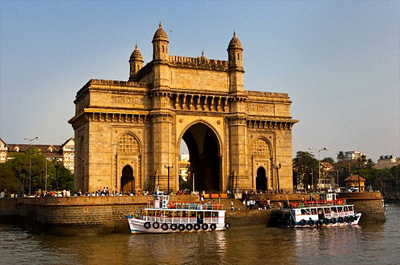Gateway of India Mumbai

The Gateway of India saw the last British troops to leave the country pass through its portal on February 28 1948, some few months after Independence Day 15 August 1947. They had been there for 194 years. (1st. Battalion of the Somerset Light Infantry)
The first stone was laid by the then Governor of Bombay, Lord Sydenham on March 31st 1913. It's a solid structure consisting of eight open doorways, above which is a perforated design. On entering the main doorway, there is a staircase behind small black doors, that lead to the top pf the Gateway where one can see the harbour. At the top are four spires enclosing a small space with large balconies on either side.
Thousand of people frequent the Gateway especially on Sunday and during evenings to enjoy cool breeze. It's also a popular haunt of snake charmers. One can see many ships that await their turn to berth at the near by docks. There are launches and cruisers anchored in front of the Gateway, that take people on the expeditions to the Elephanta Caves.
The central dome of the Gateway of India is fifteen meters (49 feet) in diameter and is twenty six meters (85 feet) above the ground which is the highest point. The construction cost Gateway of India was all borne by the Government of India.
The Gateway of India has became the most famous monument of the city Mumbai. The Gateway of India was constructed by the King George V and Queen Marry to Bombay, before the Darbar in Delhi in December 1911. The foundation stone of the Gateway of India monument was laid down on 31st day of March in the year 1913 and George Wittet 's final design of the Gateway of India was approved in August 1914.
Among main facts of Gateway of India history, there are some notable facts. The specialty about the Gateway of India is that people who comes to Mumbai greets the monument which is situated at the imperial bygone area of the Mumbai city. When people passes through the gateway of India monument the first scene that is visible is the beautiful water front at the South Mumbai.
The construction of Gateway of India is as per the style of Indo- Saracenic style. Indo- Saracenic style was more popular in Gujarat state of India in the 16th century. On the top of the Gateway of India building, there is a central dome which is having the diameter of fifteen meters.
The major purpose of the construction of the Gateway of India is the celebration of the visit of the King George V and Queen Marry to Bombay. Sir George Clark later has laid the foundation stone of the monument in 1911. The designing plan of Gateway of India monument was approved in the year 1914 and the reclamation was done in 1914 in the Apollo Bundar. The Gateway of India monument was completely designed by the George Wittet and the whole construction period took almost 4 years to be completed.
The ever first major event that happened in the Gateway of India was the passing of the First Battalion of the Somerset Light Infantry troops. That was also the last troop of the British Army to leave the country of India after independence. This event was happened on 28th of February 1948.
The Gateway of India monument faces the beautiful scene of Arabian ocean which attract the Mumbai city. The Gateway of India is the must visit tourist place specially visiting during the night time is fund. The Gateway of India History has everything that well preserved for the future generation to come!







